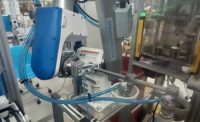Gripper Automates Tube Handling

Based in Ilshofen, Germany, Bausch+Ströbel (B+S) manufactures filling and packaging equipment for the pharmaceutical industry. The company’s machines are used worldwide to fill syringes, vials, cartridges and ampoules with liquid or powder pharmaceuticals. The machines handle every part of the process, from sterilization to labelling.
The company’s latest offering is the VarioSys flexible production system, which consists of standardized, automated processing modules that plug-and-play into a clean-room enclosure. Interchangeable modules are available for cleaning, sterilizing, filling and closing various containers. There’s even a module for freeze-drying.
Recently, B+S introduced a new VarioSys module for processing plastic tubs full of ready-to-use vials. Equipped with two compact six-axis robots, the module automatically opens each tub, removes the vials, and passes them to the next module for further processing. One robot handles the tubs and removes a heat-sealed plastic cover. The other handles the vials. The module can process up to 60 tubs per hour.
In the past, the process of opening the tubs and removing the vials would have to be performed by a technician through two glove-ports in the module. Automating the process with two robots saves time, space and labor.
B+S worked with Zimmer Group to develop grippers for handling the tubs and vials. Besides ensuring optimal interaction with the robots, the big challenge for Zimmer was that the grippers would be used in a clean room. This excluded the use of pneumatic grippers, due to the air lines and exhaust air. A mechatronic gripper was the only way to go.
The grippers would also have to meet specifications for technical cleanliness, because they come into direct contact with syringes, vials and nests. Most commercially available grippers, even mechatronic ones, generate particulates during operation. For example, abrasion between the gripper’s moving parts can produce tiny particles that could contaminate a pharmaceutical. As a result, the grippers are enclosed in a removable sheath to prevent particles from intruding into the process.
Flexibility was another important design specification. B+S wanted the new module to handle a range of tub and vial sizes.
The two grippers best-suited to the task were Zimmer’s GEH6180IL and GEH6040IL electric grippers. Both have a large stroke and a servo drive with an integrated controller. Brushless drive technology provides control over force, speed and position. Because the grippers handle fragile glass and plastic parts, they have a mechanical self-locking mechanism, which prevents a vial from falling in the event of a power failure.
“The ease of configuring parameters and the many additional features of the GEH grippers were very appealing to us,” says Philip Messerschmidt, B+H development engineer.
Both grippers carry an ingress protection rating of IP54 and can perform up to 5 million cycles without maintenance. Their operating temperature ranges from 5 to 50 C. Their jaws can be positioned with a repeatability of ±0.02 millimeter.
With an adjustable stroke of 80 millimeters per jaw, the Model GEH6180IL weighs 2.6 kilograms and can produce a gripping force of 150 to 1,800 newtons. The gripper’s jaws can be as long as 160 millimeters and weigh up to 1 kilogram. The maximum travel speed per gripper jaw is 50 millimeters per second.
With an adjustable stroke of 40 millimeters per jaw, the Model GEH6040IL weighs 0.7 kilogram and can produce a gripping force of 10 to 180 newtons. The gripper’s jaws can be as long as 100 millimeters and weigh up to 0.3 kilogram. The maximum travel speed per gripper jaw is 120 millimeters per second.
Zimmer modified the grippers for the B+H application. With the GEH6180IL gripper, for example, Zimmer added a lateral connection via a flush connector. B+H also appreciated the fact that the grippers have only one cable outlet. That’s a big advantage for the tight space conditions in a clean room. Equipping the grippers with IO-Link makes it easy to export operational data, such as temperature, position and cycle count.
“Active and open communication between Zimmer Group experts and our team characterized our collaboration and confirmed our decision to use the Zimmer grippers,” adds Lukas Bindewald, product manager at B+S. “As a result, new potential projects are already being discussed for the future.”
Looking for a reprint of this article?
From high-res PDFs to custom plaques, order your copy today!






